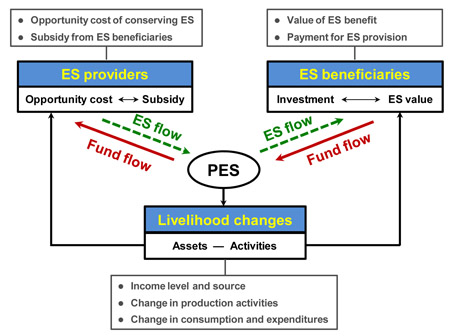| Location: Home>News>Events |
| Progress in payment for ecosystem services |
|
|
Assessment framework of the PLDL program Despite broad interest in using payment for ecosystem services to promote changes in the use of natural capital, there are few ex-post assessments of impacts of payment for ecosystem services programs on ecosystem service provision, program cost, and changes in livelihoods resulting from program participation. Collaborating with the researchers from Stanford University and Minnesota University, Ouyang Zhiyun’s research group from Research Center for Eco-Environmental Sciences, Chinese Academy of Sciences evaluate the Paddy Land-to-Dry Land (PLDL) program in Beijing, China, and associated changes in service providers’ livelihood activities. The PLDL is a land use conversion program that aims to protect water quality and quantity for the only surface water reservoir that serves Beijing, China’s capital city with nearly 20 million residents. The research shows that the PLDL generates benefits of improved water quantity and quality that exceed the costs of reduced agricultural output. The PLDL has an overall benefit-cost ratio of 1.5, and both downstream beneficiaries and upstream providers gain from the program. Household data show that changes in livelihood activities may offset some of the desired effects of the program through increased expenditures on agricultural fertilizers. Overall, however, reductions in fertilizer leaching from land use change dominate so that the program still has a positive net impact on water quality. This program is a successful example of water users paying upstream landholders to improve water quantity and quality through land use change. Program evaluation also highlights the importance of considering behavioral changes by program participants. The study provides a framework for incorporating household livelihood changes in an assessment of a PES program, which has important policy and methodological implications for PES design and assessment, future research on PES, livelihoods, and the environment. The example also highlights how PES programs can induce activities that could have a positive or negative total effect on environmental outcomes, and serves as a reminder that households react strategically to the incentives they face. PES policy design should carefully consider the right set of institutions that will facilitate long-term positive environmental and livelihood outcomes, while avoiding or minimizing the possible negative ones. The results were published online on Proceedings of the National Academy of Sciences (PNAS, http://www.pnas.org/content/early/2013/08/30/1312324110.full.pdf+html). The work was supported in part by National Natural Science Foundation of China and special fund of State Key Laboratory of Urban and Regional Ecology of China. State Key Laboratory of Urban and Regional Ecology September 5, 2013 |
